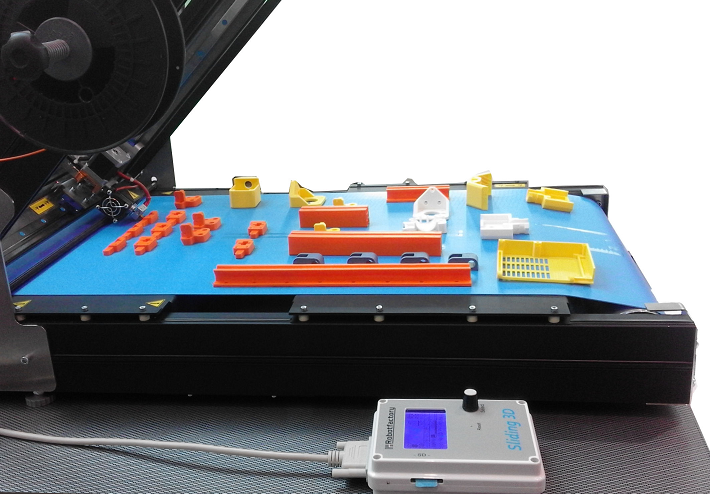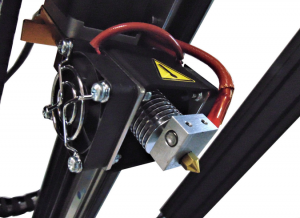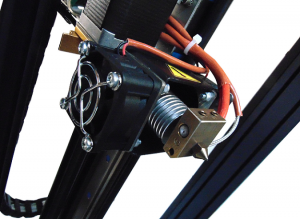Over the last several years, 3D printers that use conveyor belts as limitless build platforms have been growing more popular. In 2017, Italian company Robot Factory launched its own FFF version, called Sliding-3D, which can help companies achieve more sustainable manufacturing processes with its 45° extruder and uninterrupted 3D printing. Now, Robot Factory is introducing a new version of the 3D printer, called Sliding-3D Plus because it can print with more technologically advanced, high-performance materials at high temperatures.
The new Sliding-3D Plus was developed for maximum performance 3D printing of materials, like Ultem (PEI), Thermec, PPS, PEEK, and carbon fiber, that require extrusion temperatures between 280 °C and 480 °C. The company is now offering its professional Sliding-3D system in two different versions that still offer the same main features but are, as Robot Factory puts it, “characterized by different arrangements.”
First things first…because of Sliding-3D’s infinite print bed, large objects and multiple parts in a series can be fabricated on the system. Additionally, this conveyor belt bed ensures an uninterrupted work cycle – any time a print is completed, a new one will automatically begin. The moving bed sends the print forward until it detaches itself upon reaching the front roller, falling into a waiting collection container below.
The Sliding-3D Standard uses a mounted extruder block which supports temperatures up to 280°C, which works for more common materials like HIPS, nylon, PETG, PLA, and TPU. But the new Sliding-3D Plus has an extruder block that comes with a mounted Type K – Class I thermocouple, which allows the nozzle to support temperatures up to 480°C.
- Standard
- Plus
Robot Factory explained, “In the Sliding 3D Plus version the extruder cooling system was upgraded and the quick nozzle changed system was adopted. Furthermore, in the Plus version the belt is made with new materials that can withstand temperatures on the heated bed up to over 130 °C.”
There are a few other differences between the Sliding-3D Standard and Plus versions, including the heating block: it’s made of aluminum for the Standard, but a different material for the Plus. Two 40 x 10 fans make up the extruder cooling system for the Standard, while the Plus has two 40 x 20 fans. Finally, a socket wrench is needed to change the nozzles out for the Sliding-3D Standard, but the Sliding-3D Plus comes with a quick nozzle complete change system.
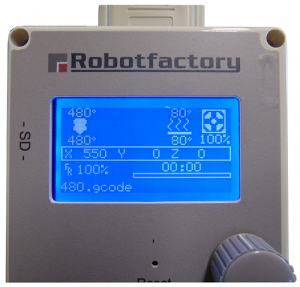 Now on to the similarities – both versions have the same build volume of 410 x 380 x ∞ (endless) mm and the same 36 kg weight, with an external PAD control device. Each one has a 0.4 mm nozzle for fine details and a 0.6 mm one for larger, high speed prints. Print jobs can be controlled with an SD card, and customers can also request an additional PAD that has an LCD color touchscreen, WiFi, and a USB port. Customers can also get the OctoPrint system to remotely manage, and extend, printer control.
Now on to the similarities – both versions have the same build volume of 410 x 380 x ∞ (endless) mm and the same 36 kg weight, with an external PAD control device. Each one has a 0.4 mm nozzle for fine details and a 0.6 mm one for larger, high speed prints. Print jobs can be controlled with an SD card, and customers can also request an additional PAD that has an LCD color touchscreen, WiFi, and a USB port. Customers can also get the OctoPrint system to remotely manage, and extend, printer control.
Robot Factory’s high quality Sliding-3D systems are strong and stable because of their aluminum structural profiles and guides made of stainless steel with double ball bearing carriage, which ensures high precision. Sliding-3D uses the Simplify3D software suite, which provides an axis translation program to manage the inclination of the system’s 45° 3D printing layers and the serialization of the printing jobs.
Because of this print angle, Sliding-3D can offer some unique advantages when compared to more conventional systems, such as the layers providing more rigidity to the 3D printed model due to an increase on the internal forces between each layer. Surface quality is not negatively affected as there are no contour lines on the curved surfaces, and because minimally experienced users can exploit a model’s self-supporting corner during the design phase, no support structures are necessary for overhangs, which saves time, money, material, and energy consumption.
Because support structures aren’t necessary, this reduces the environmental impact of Sliding-3D systems – making them more eco-friendly.
Sliding-3D provides good adhesion, as its print beds are made with a special composite material that doesn’t require the use of any glues or adhesive sprays. This material actually prevents model detachment during 3D printing, and “favors the detachment at the end.” The bed is also heated, which helps improve print quality by preventing warping.
While the Standard and Plus versions of the Sliding-3D printer have differently sized fans in their extruder cooling system, the double fans in each create an air flow that perfectly cools the extruder and keeps the nozzle at its maximum temperature. Upon request, the systems can also be equipped with a protective BOX, made of transparent polycarbonate and aluminum profiles, for the kind of controlled temperature environment that’s needed when you’re dealing with advanced materials.
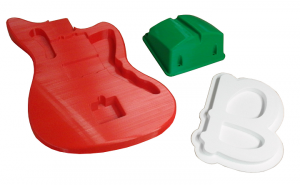 Robot Factory’s Sliding-3D systems don’t require a lot of maintenance to achieve good results, other than cleaning the print nozzles and maintaining a good distance between the nozzle and the moving print bed.
Robot Factory’s Sliding-3D systems don’t require a lot of maintenance to achieve good results, other than cleaning the print nozzles and maintaining a good distance between the nozzle and the moving print bed.
The Sliding-3D systems, both the Standard and the Plus, can be used to make 3D models with high stability and quality in many industries. Because they can print large objects as well as multiple parts in a series, the 3D printers can fabricate everything from customized objects, functional prototypes, and and medical aids to design check parts, manufacturing aids, and 3D models in one-to-one scale for developing assembly processes.
Discuss this story and other 3D printing topics at 3DPrintBoard.com or share your thoughts in the Facebook comments below.
[Images: Robot Factory]Subscribe to Our Email Newsletter
Stay up-to-date on all the latest news from the 3D printing industry and receive information and offers from third party vendors.
You May Also Like
3D Printing Webinar and Event Roundup: April 7, 2024
Webinars and events in the 3D printing industry are picking back up this week! Sea-Air-Space is coming to Maryland, and SAE International is sponsoring a 3D Systems webinar about 3D...
Roboze Brings Performance Polymer 3D Printing to SoCal via New Partnership
High-performance polymer 3D printing firm Roboze has been steadily working to expand its global footprint, with a firm eye on distributed manufacturing, particularly with regard to the oil and gas,...
3D Printing Webinar and Event Roundup: March 3, 2024
In this week’s roundup, we have a lot of events taking place, including SPE’s ANTEC 2024, Futurebuild, the AAOP Annual Meeting, JEC World, and more. Stratasys continues its training courses,...
Advanced Manufacturing Firm Zeda Acquires The Orthopedic Implant Company
Zeda, the San Francisco-based provider of advanced manufacturing solutions, announced that it has acquired The Orthopedic Implant Company (OIC), a medical device manufacturer based in Reno, Nevada, for an undisclosed...


